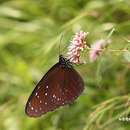en
names in breadcrumbs


Euploea is a genus of milkweed butterflies. The species are generally dark in coloration, often quite blackish, for which reason they are commonly called crows. As usual for their subfamily, they are poisonous due to feeding on milkweeds and other toxic plants as caterpillars. The latter are aposematically colored to warn off predators from eating them, and the adult butterflies are often mimicked by unrelated species which are not or less poisonous.
Listed alphabetically.[3]
This genus has a large number of junior synonyms, due in part to Moore[5] committing what probably ranks as one of the most drastic cases of oversplitting in the history of zoology:
Crastia Hübner, 1816
Trepsichrois Hübner, 1816
Salpinx Hübner, 1819
Eudaemon Billberg, 1820
Terpsichrois Hübner, 1821 (lapsus)
Euplaea Boisduval, 1832 (lapsus)
Calliploea Butler, 1875
Macroploea Butler, 1878
Stictoploea Butler, 1878
Euplea W.F. Kirby, 1879 (lapsus)
Adigama Moore, 1880
Andasena Moore, 1883
Betanga Moore, 1883
Bibisana Moore, 1883
Chanapa Moore, 1883
Chirosa Moore, 1883
Danisepa Moore, 1883
Deragena Moore, 1883
Gamatoba Moore, 1883
Glinama Moore, 1883
Hirdapa Moore, 1883
Isamia Moore, 1883
Karadira Moore, 1883
Lontara Moore, 1883
Mahintha Moore, 1883
Menama Moore, 1883
Mestapra Moore, 1883
Nacamsa Moore, 1883
Narmada Moore, 1880
Nipara Moore, 1883
Oranasma Moore, 1883
Pademma Moore, 1883
Patosa Moore, 1883
Penoa Moore, 1883
Pramasa Moore, 1883
Pramesta Moore, 1883
Rasuma Moore, 1883
Sabanosa Moore, 1883
Saphara Moore, 1883
Sarobia Moore, 1883
Satanga Moore, 1883
Selinda Moore, 1883
Tabada Moore, 1883
Tagata Moore, 1883
Tiruna Moore, 1883
Tronga Moore, 1883
Vadebra Moore, 1883
Vonona Moore, 1883
Anadara Moore, 1883 (non Gray, 1847: preoccupied)
Doricha Moore, 1883 (non Reichenbach, 1853: preoccupied)
Karadina Moore, 1891 (lapsus)
Chirosia Sharp, 1904 (lapsus)
Daniseppa Fruhstorfer, 1910 (lapsus)
Pamasa Fruhstorfer, 1910 (lapsus)
Rausuma Fruhstorfer, 1910 (lapsus)
Ironga Martin, 1914 (lapsus)
Makroploea Martin, 1915 (lapsus)
Eupolea Hulstaert, 1931 (lapsus)
Ramasa Hulstaert, 1931 (lapsus)
Euploea is a genus of milkweed butterflies. The species are generally dark in coloration, often quite blackish, for which reason they are commonly called crows. As usual for their subfamily, they are poisonous due to feeding on milkweeds and other toxic plants as caterpillars. The latter are aposematically colored to warn off predators from eating them, and the adult butterflies are often mimicked by unrelated species which are not or less poisonous.